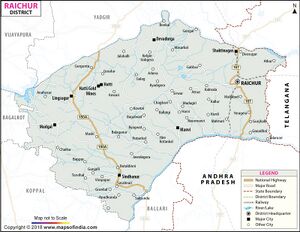Maski
| Author:Laxman Burdak, IFS (R) |

Maski (मासकी) is a town and an archaeological site in Lingsugur taluq in the Raichur district of the state of Karnataka, India.[1]
Variants
- Masaki मासकी, कर्नाटक (AS, p.741)
- Masangi मासंगी = Masaki मासकी, कर्नाटक, (p.741)
- Maski river/Maski River मासकी नदी
Location
It lies on the bank of the Maski river which is a tributary of the Tungabhadra.
Origin
Maski derives its name from Mahasangha or Masangi .
History
The site came into prominence with the discovery of a minor rock edict of Emperor Ashoka by C. Beadon in 1915.[2] It was the first edict of Emperor Ashoka that contained the name Ashoka in it instead of the earlier edicts that referred him as Devanampiye piyadasi[3][4] This edict was important to conclude that many edicts found earlier in the Indian sub-continent in the name of Devanampiye piyadasi, all belonged to Emperor Ashoka.[5] The edict is etched on a rock-face of Durgada-gudda, one of the gneissic outcrops that are present in the site.
Maski is also the place on the Raichur Doab which was also under the hegemony of the imperial Chola empire and it was here that Rajendra Chola I defeated Jayasimha II, the Western Chalukya ruler in battle in 1019-1020 AD.[6]
Maski in Lingsugur taluq is one of the oldest sites in the State. Here excavations have brought to light remains of the neolithic age — bones, flints, implements, — and of the Asokan and Buddhist ages. A miniature head of Buddha in crystal which dates from somewhere between 200 to 300 B.C. is an exquisite discovery. Coins discovered tell the tale of the Satavahana dynasty whose last great emperor was Gautamiputra Swami Sri Yajna Satakarni, area 186 A.D. What happened in this part of Andhradesa after the Satavahanas is the usual history of the Saka usurpers, the Cholas, the Pallavas and their successors, and of the two Chalukyas, the Rashtrakutas and the Kalachuris. Maski is indeed an antiquarian’s delight.[7]
Minor Rock Edict of Ashoka
The Maski version of Minor Rock Edict No.1 was historically especially important in that it confirmed the association of the title "Devanampriya" ("Beloved-of-the-Gods") with Ashoka:[8][9]
|
[A proclamation] of Devanampriya Asoka. Two and a half years [and somewhat more] (have passed) since I am a Buddha-Sakya. [A year and] somewhat more (has passed) [since] I have visited the Samgha and have shown zeal. Those gods who formerly had been unmingled (with men) in Jambudvipa, have how become mingled (with them). This object can be reached even by a lowly (person) who is devoted to morality. One must not think thus, — (viz.) that only an exalted (person) may reach this. Both the lowly and the exalted must be told : "If you act thus, this matter (will be) prosperous and of long duration, and will thus progress to one and a half. |
| Maski Minor Rock Edict of Ashoka.[10] |
मासकी
विजयेन्द्र कुमार माथुर[11] ने लेख किया है ...मासकी AS, p.741) नामक स्थान कर्नाटक में स्थित है. अशोक के लघु शिलालेख के यहां मिलने के कारण यह स्थान प्रसिद्ध है. अशोक के समय यह स्थान दक्षिणापथ के अंतर्गत तथा अशोक के साम्राज्य की दक्षिणी सीमा पर था. मास्की के अभिलेख की विशेष बात यह है कि उसमें अशोक के अन्य अभिलेखों के विपरीत मौर्य सम्राट का नाम देवानंप्रिय (=देवानां-प्रिय) के अतिरिक्त अशोक भी दिया हुआ है. जिसे देवानांप्रिय उपाधि वाले [p.742]: (तथा अशोक नाम से रहित) भारत के अन्य सभी अभिलेख सम्राट अशोक के सिद्ध हो जाते हैं. मासकी के अतिरिक्त गुजर्रा नामक स्थान पर मिले अभिलेख में भी अशोक का नाम दिया हुआ है.
अशोक के शिलालेख के अतिरिक्त मास्की से 200-300 ई. की, स्फटिक निर्मित बुद्ध के सिर की प्रतिमा भी उल्लेखनीय है. अंतिम सातवाहन नरेश सम्राट गौतमीपुत्र स्वामी श्रीयज्ञ सातकर्णी (लगभग 186 ई.) के समय के, सिक्के भी यहां से प्राप्त हुए हैं. कुछ विद्वानों का मत है कि मौर्य काल में दक्षिणापथ की राजधानी सुवर्णगिरि जिसका उल्लेख बौद्ध साहित्य में है, मासकी के पास ही थी.
External links
References
- ↑ Ghosh, Amalananda (1990) [1990]. An Encyclopaedia of Indian Archaeology. BRILL. ISBN 90-04-09262-5.p.282
- ↑ Dikshitar, Ramachandra V. R. (1993) [1993]. The Mauryan Polity. Motilal Banarsidass Publications. ISBN 81-208-1023-6. p.41
- ↑ Handa, O. C. (1994) [1994]. Buddhist Art and Antiquities of Himachal Pradesh. Indus Publishing. ISBN 81-85182-99-X. p.197
- ↑ Smith, Vincent Arthur (1998) [1998]. Aśoka: The Buddhist Emperor of India. Asian Educational Services. ISBN 81-206-1303-1.p.5
- ↑ Handa, O. C. (1994) [1994]. Buddhist Art and Antiquities of Himachal Pradesh. Indus Publishing. ISBN 81-85182-99-X. p.197
- ↑ (2003), K.A.Nilakanta Sastri, p. 166
- ↑ History And Legend In Hyderabad, Department of Information and Public Relations, 1953,pp.109-110
- ↑ The Cambridge Shorter History of India. CUP Archive. p. 42.
- ↑ Gupta, Subhadra Sen (2009). Ashoka. Penguin UK. p. 13. ISBN 9788184758078.
- ↑ Inscriptions of Asoka. New Edition by E. Hultzsch (in Sanskrit). 1925. pp. 174–175.
- ↑ Aitihasik Sthanavali by Vijayendra Kumar Mathur, p.741-742

